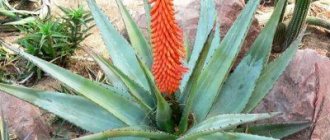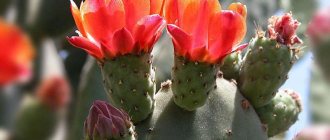Botanical description
Lithops is a genus of succulents, it belongs to the Aizaceae family. The height and diameter of the plant do not exceed 5 cm.
- The leaves are fleshy, fused at the base, separated by a hollow slit. The leaf plates are dense, can be green, brown, gray, red-brown, covered with spots and patterns.
- The peduncle appears from the hollow in late summer - autumn. The flowers are white, yellow or orange, up to 3 cm in diameter.
- The root system is long and branched.
Forced to adapt to a dry climate, the plant has an unusual development cycle - every year an old pair of leaves is replaced by a new one.
Varietal varieties of lithops with names and photos
Just under 40 species of this plant have been described, varying in size, shape and color. Many of them are very similar to each other, and only specialists can determine whether they belong to a specific species. In addition, lithops are capable of changing their color within certain limits, masquerading as the growing conditions. A little more than a dozen of them, and their numerous varieties, are suitable for planting and growing at home.
Lithops Leslie
This variety is the most popular for growing at home. The leaf blades are small, no more than 2 cm, in size and have the shape of an incised egg flattened on top. Painted in gray-pink tones with a muted coffee tint. Gray or coffee-colored patterns are scattered across the top flat surface. It blooms in white or yellow, the inflorescences have a delicate, pleasant aroma.
Lithops Aukamp
Medium-sized succulent, up to 3 cm in width, leaf blades with a flat top. The leaves are brown-green, sometimes with a purple or gray tint. The flat top part is painted in a darker tone, which has the appearance of a large spot. Along its edges there is a lighter rim of the ornament. In August, a bright yellow flower grows from a deep gap between the leaves, the diameter of which almost coincides with the size of the plant itself.
Lithops Optics
The leaf blades of this variety can have a gray-green or purple-crimson color, an elongated oval shape with a deep cleft in the middle. The size usually does not exceed 2 cm. The inflorescences are of medium diameter, white with a yellow core, and have a weak aroma.
Lithops Pseudotruncatella
The variety is quite large for its group with leaves 3 cm across and about 4 cm in height. Painted in a gray-brown palette with a pinkish tint. The upper flattened surface is decorated with thin strokes of a darker color. The flower is large, yellow.
Lithops olive green
The name accurately characterizes the color of this variety, which gives the impression of a cut in a horizontal plane with its surface not yet dry and barely covered. Both in height and width the plant does not exceed 2 cm. The surface of the leaves is matte, the bud is yellow in color, resembling a chamomile in shape.
Lithops Marble
The name of this succulent is due to the original marble surface pattern. The leaf blades have a standard shape for the culture and a size of no more than 2 cm. They are painted in gray-green tones. The inflorescences are large, white with a yellow heart of still unopened petals. They have a pleasant light smell.
Lithops brownish
The appearance has a striking resemblance to real stones and is almost invisible against the background of granite chips. Colored in brown-brown shades with spots of different sizes. The flowers are large, light yellow, chamomile type.
Lithops kegleformes
Medium-sized species with red-brown leaf blades. The upper flat part has a furrowed surface with intricate relief. It blooms in a yellow or orange palette with large flowers, behind which the plant itself may not be visible. With age, it tends to grow due to lateral shoots.
Lithops is beautiful
The variety is up to 5 cm wide and no more than 3 cm high. It has a highly decorative coloring in muted yellow-brown tones with intricate ornamentation of the flat surface part. The groove is shallow, weakly expressed. The flowers are snow-white, fragrant, large in size.
Lithops falsetruncata
Colored from green-gray to pink-brown tones, characteristically narrowed at the bottom and widening at the top. The pattern is formed from multiple broken lines and dots. The flowers are large, dandelion-like, bright golden in color.
Lithops divided
It differs from other varieties in its taller growth and deep, pronounced cleft. The color is greenish-gray, with faint spotting. The leaves have a beveled surface, with slight folding at the cut site, resembling an elephant's foot in appearance. The inflorescences are small and yellow.
Lithops saleros
A variety of gray-stony color with tightly compressed leaves. The color of the apical part is darker, olive-brown. It blooms with large white inflorescences that exude a pleasant aroma.
Lithops bromfield
A cone-shaped compact succulent, painted in unusual yellow-burgundy tones. The flat top part is decorated with bright, intricate patterns. The flowers are bright yellow, large, fragrant.
Lithops Coles
The appearance of this variety resembles quail eggs in appearance. The leaves have an almost perfectly round shape, almost not flattened on top. Dark dots and spots are scattered chaotically on a gray-sand background. It blooms in September with large yellow, pleasantly smelling inflorescences.
Lithops Compton
Strongly divided half-sheets are covered with a brownish-pinkish mesh along the upper convex surface. It blooms brightly, the inflorescence is colored in two tones - yellow at the edges and white in the center.
Lithops mix
It is a group of succulents with similar species characteristics, from which, with good care, you can get a very picturesque, multi-colored composition with a variety of ornamental patterns.
Varieties for indoor keeping
About 40 species of Lithops are known, but much fewer are grown at home. Varieties differ in different sizes, leaf and flower colors.
The most popular of them:
- Aucapm;
- Beautiful;
- divided;
- false truncated;
- brownish;
- olive green;
- Leslie;
- Optics;
- Soleros and others.
Lithops is undemanding in care, but you still need to follow some rules for the plant to feel good.
Read more about varieties suitable for indoor growing here.
Lithops is not afraid of heat and temperature changes. In summer it will grow well at temperatures of 22°C and above, but it is still not worth bringing it to 40°C. In winter, you need cooler air - 10-15°C, but not lower than 7°C.
How to grow “living stones” at home?
Germinating homemade lithops from seeds is a fascinating but labor-intensive process , very different from growing deciduous crops. It is not difficult to achieve the first shoots, but saving at least half of the seedlings will be problematic for a beginner.
Seeds require stable greenhouse conditions. Precipitation and nighttime temperature changes will kill young shoots. Preference should be given to home conditions, refusing to grow lithops from seeds in open ground.
Important : Lithops is native to the arid deserts of Botswania and Namibia, where succulents grow in poor and dry soil. These plants do not see precipitation for months, carefully storing moisture in their fleshy leaves. The main reason for the death of lithops is flooding, which can cause rotting in a few hours.
The most suitable time for planting lithops is early spring . If you have bottom heating and artificial lighting, you can sow at any time. During the first stages of germination, special attention should be paid to soil temperature. It should fluctuate between +27+30 degrees. Cooler conditions will cause the seeds to rot and mold, while excessively high temperatures will “cook” them.
How to water and spray?
Lithops prefer dry air, so they are not sprayed even in extreme heat. Water for irrigation should be filtered and warm.
Plants should be watered rarely, but abundantly, and at the same time make sure that water does not get on the leaves, especially in the gap.
In the first half of summer, lithops has a dormant period and does not require watering. From mid-August, watering is gradually increased to 2 times a month, and then reduced again to stop by the beginning of winter. With the onset of spring, they begin to water the plant again, bringing it to the usual rate - once every two weeks, and by summer they again stop watering completely.
When to plant: the right time of year for propagation
Experienced gardeners advise breeding lithops from early spring to late summer, as they are very light-loving. But you can start growing exotic plants in the cold season, only in this case it will be necessary to provide the flowers with additional lighting.
Despite the fact that lithops love light, it has been noted that seeds germinate best when there are significant fluctuations in air temperature. Therefore, if there is additional lighting, then you can start breeding them in the off-season.
Priming
For lithops, store-bought soil for succulents or other universal soil that does not contain peat is suitable. You can also prepare the soil mixture yourself. It should be light and water-permeable.
To do this, mix turf soil with coarse sand in equal proportions. Another substrate option is sheet soil, brick chips, sand, clay and coal (2: 2: 4: 1: 1).
The resulting mixture is calcined in the oven for at least 30 minutes.
Preparing the soil and choosing a pot for planting
Succulents need light, breathable soil with low nutritional value.
Succulent collector Jacques Strydom (South Africa) recommends paying attention to the following points when preparing the soil:
- should be easily wetted with water throughout the entire volume;
- should not interfere with root growth (large particles can interfere with the development of the taproot of young seedlings);
- should not retain excessive amounts of moisture (lithops seedlings are more demanding of moisture than adult plants; a lack of it can inhibit development, and an excess can lead to root rot).
The safest way to make the mixture yourself is:
- 1 part of ordinary land;
- 1 part peat (purchased soil is suitable);
- 2 parts of mineral components (sand, perlite, brick chips, etc.).
Soil particles, as I wrote above, should be quite small. You can sift the mixture through a colander, for example. It is also helpful to lightly wet the ingredients when mixing.
After mixing the components, the soil must be steamed or calcined in the oven at 150 degrees for about half an hour. This will help get rid of pathogens.
On a note. Adding 100 g of charcoal (in small pieces) per 1 kg of prepared soil will reduce the risk of fungal infection.
Small wide pots, 3-5 cm high, with drainage holes in the bottom, are suitable for sowing lithops. How to fill the container:
- 1 cm of drainage material;
- 1.5 - 2 cm of substrate;
- 2-3 mm of coarse sand (this will also serve as a support for seedlings).
It is advisable to leave at least 2 cm free to the top edge of the container.
Flowering and dormant period
The flowering period occurs in summer or autumn (depending on the variety). At the end of August, a peduncle forms and in the fall you can admire yellow, white or orange flowers. Flowering lasts about two weeks, and the buds close at night to bloom again by noon.
The dormant period of Lithops is divided into two parts: summer and winter. At this time, its growth completely stops. The summer dormant period lasts from June-July to mid-August. The plant's winter rest extends from late autumn to early spring.
Lithops flowering
By the end of summer, the deep gap between the two voluminous leaves begins to widen even more, and a bud appears in the light. The flowers of this succulent have an external resemblance to cactus or daisies; they can be small and inconspicuous or quite large and bright. The petals are narrow, often white-beige or yellowish. A narrow elongated tube is formed in the center. The diameter of the flower often exceeds the size of the plant itself; it lives for about 2 weeks. The buds of this succulent open daily and close again at night.
Interestingly, under the influence of bright sun, lithops can change their color, for example, from white to pink or from yellow to purple-red.
Transplantation after purchase and more
The purchased lithops is immediately replanted, completely replacing the soil, since the store-bought substrate is too heavy and is not suitable for long-term development of the plant.
Subsequently, succulents are replanted every three to four years to avoid soil depletion.
The best time for this is early spring.
- First, prepare a new pot, a couple of centimeters wider than the previous one.
- Fill in a drainage layer of expanded clay or crushed brick, and then the prepared soil mixture.
- Water the plant, remove it from the old pot and carefully clean the roots from the soil with a toothpick.
- A lithops with straightened roots is placed in the depression made and sprinkled with earth up to the root collar. You can sprinkle a little sand on top or lay small pebbles.
- The transplanted plant is not watered for several days.
Caring for young plants
Young lithops are kept at room temperature and in bright light. Water them no more than once a week, moistening the soil with a pipette or rubber syringe.
When the young Lithops reaches a height of 6-9 mm, the soil surface between the plants is covered with vermiculite, expanded clay chips, and coarse sand. If the sprouts fall to one side, they are carefully straightened with a wooden toothpick and supported with a pebble.
Grown seedlings @Esin İşcan, Flickr
First moult @HJKim25, Flickr
You can plant seedlings after the first molt (approximately at the age of six months), but it is better to wait until a year to replant, when the “living stone” has gained maximum strength.
Important! During molting, plants should not be sprayed. Water ingress can cause rot.
Reproduction
Lithops can be propagated by seeds and cuttings, with the seed method being the main one.
Growing from seeds
- Purchased seeds are soaked for several hours in warm water to speed up germination.
- The seeds are placed on previously disinfected and moistened soil without being buried.
- They are covered with glass or film on top and placed in a warm place, ventilated regularly.
- After germination, the film is removed and the soil is moistened with a spray bottle.
- When the seedlings grow to 10 mm, a layer of expanded clay is added to the surface of the ground, and after a year the grown lithops are planted in separate containers.
Plant side shoots
This breeding option is rarely used. It happens that when the foliage changes, not one, but 2-3 pairs of new leaves are formed. When replanting, such a plant can be divided and planted in separate containers.
Sowing stages
Before sowing a plant, you should decide on the size of the seedlings. The plant is very capricious at an early age, and even experienced collectors lose up to a third of the seedlings. For the first tests, it is advisable to choose common non-hybrid varieties that germinate better, are less demanding on conditions and also look impressive.
In nature, lithops grow in dense groups and do not like to be alone . Division of one specimen occurs in adulthood, so it is better to sow them together and as close to each other as possible.
Due to their uniqueness, lithops seeds cannot be purchased at a regular flower shop. The highest quality planting material can be purchased secondhand from private breeders and collectors. Such seeds have the best germination rate and are adapted to the conditions of a standard apartment.
There are quite a few conscientious lithops growers, but due to their popularity in narrow circles, information about purchasing seeds can be easily found on specialized Internet resources. Real lithops seeds are dusty and difficult to see , which increases the risk of running into a fake.
Under no circumstances should you purchase lithops seeds from dubious online stores. Externally, the seeds are little noticeable, and the buyer risks running into an ordinary weed at an incredible price.
For sowing you will need a number of items:
- plastic container for planting;
- drainage;
- coarse sand;
- fine gravel;
- turf soil or mixture for cacti;
- polyethylene.
The container in which the seeds will be sown must be equipped with drainage holes . Due to their microscopic size, the seeds are not pre-soaked. The key to healthy seedlings is sterile soil. Before planting the succulent, the soil should be calcined in the oven or spilled with a weak solution of potassium permanganate. After preparations, you can safely begin planting.
- Drainage a couple of centimeters high is poured onto the bottom of the bowl. Moisture-intensive expanded clay should be abandoned. Broken shards are perfect for these purposes.
- The soil for planting is mixed from sand and fine gravel in equal proportions. A little soil for cacti is added to them. A small handful of the prepared mixture should be squeezed in your hand. Suitable soil will not stick together and will fall back freely.
- The resulting soil is shed with warm, settled water.
- Lithops seeds are very small. To make sowing easier, it is recommended to take a small white sheet of paper and pour them onto the fold, and then send them into the soil.
- Under no circumstances should the seeds be buried in the ground; they can be sprinkled on top with a very thin layer of sand.
- The greenhouse is covered with polyethylene or cling film. Small ventilation holes are made in it in advance.
- The bowl with the seeds is sent to a warm place.
Tip : A central heating battery is perfect as a source of bottom heating. If there is none or the apartment is not heated, you can use a towel or shoe dryer. A heated reptile mat is also suitable for these purposes. It has a temperature control system and is sold in pet stores.
An improvised greenhouse must be constantly heated . The soil should be moistened as the top layer dries and exclusively from a small spray bottle. In the morning and evening, the greenhouse is ventilated for 15-30 minutes.
The first shoots appear after 3-4 days. They look like little green balls. After the vast majority of seeds have germinated, the bowl with seedlings can be removed from the heating and placed on the backlight without removing the cellophane film.
Even on southern, sunny windows, babies need additional lighting for at least 14-16 hours a day. Cool white LED lamps with a luminous heat of 6500 K are perfect for these purposes.
Young plants require protection from direct sunlight. Lithops should be gradually accustomed to bright sunlight to avoid burns and further death.
We recommend watching a video about growing lithops from seeds:
Useful video
The video provides important tips for caring for the plant:
Lithops is an interesting and unpretentious plant that even a novice gardener can grow. If all care recommendations are followed correctly, it will delight you with its unusual appearance and even flowering for a long time.
READ ABOUT OTHER SUCCULENTS: SEDUM, SEDUM, HAWORTHIA, ECHEVERIA.
Why isn't it growing?
For proper plant development, you need to carefully monitor soil moisture. Lithops comes from arid places and does not like stagnant moisture, so abundant watering is contraindicated for it. Sometimes it can be wiped with a damp cloth, but no water should remain on the surface of the plant.
Often it is a violation of the watering regime that causes a small lithops to stop growing. If, nevertheless, the soil is waterlogged, it is necessary to completely stop watering and wait until the soil dries completely.
Illness can also cause growth retardation. Lithops are quite resistant to disease, especially in hot weather. However, as the temperature drops they become more susceptible. The most common pests for lithops are:
- Aphid. She sucks the juice from the leaves. In the initial stages, an infusion of hot pepper or garlic will help fight it, but if more serious measures are needed, you can use insecticides (Aktellik or Aktara).
- Spider mite . If a white coating appears, the plant should be treated with Actellik solution. Treat once every 5-7 days.
- Mealybug. If the disease is noticed in the early stages, you can wash the plant with soap and water. In more advanced cases, treatment with Actara or Phosfamide will help. Process once a week.
- Root rot. To combat it, you need to dig up the plant, inspect the roots and remove areas damaged by the disease. The treated roots of the plant are immersed in a 2% solution of Bordeaux mixture for half an hour, after which the lithops can be planted in new soil.
Lithops are amazing plants that amaze with their appearance. They are quite unpretentious in care, but under the created comfortable conditions they can grow into an entire colony, capable of delighting with bright flowering.
Lithops - home care
In the wild, living stone succulents survive in the harshest and most arid conditions, but to successfully cultivate them in an apartment requires a lot of knowledge and effort:
- The plant, like all cacti, loves sunlight. Feels good on south and south-east windows.
- In the midday heat, they must be shaded so that the leaves do not receive additional burns, and in severe winters they must be additionally illuminated with special lamps.
- Lithops are placed in a permanent place and are not transferred, the pot does not rotate.
- In summer, the air temperature in the room with live stones should be about +20…30℃. In winter, they enter a period of rest, during which the air should not be warmer than +8…12℃.
- The succulent is provided with moderate watering in accordance with the development period.
- From April to September, you need to apply special fertilizers for cacti in liquid form no more than once a month.
- Some gardeners advise using preventative soil treatment with insecticidal preparations (Aktara) in late autumn, when the plant goes into dormancy.
- Flowers are grateful for replacing soil in pots and replanting, which will be carried out no more than once every 2 years.
Lithops - care after purchase
In rare flower shops you can find lithops for sale. More often they are purchased from professional gardeners who successfully grow these rare flowers. In order for the purchased lithops to take root, they are provided with special care in the first weeks after changing their habitat:
- The flower is transplanted into dry soil and placed in a permanent place, which is similar in conditions to those in which it was located before purchase.
- The plant is protected from drafts, coolness and excess sunlight.
- Watering is carried out guided by the phases of flower development.
- Some professionals recommend leaving the flower pot in quarantine, away from other house plants, for at least a week.
Watering lithops
The main feature of lithops care at home is the cyclic watering regime corresponding to the phases of the plant’s life cycle:
- At the beginning of summer, the plant goes into so-called hibernation. In nature, this is necessary for survival in extreme heat. At this time, in the desert, the plant does not see water for months, using the liquid accumulated in the leaves and roots. Because of this, it is not recommended to moisten the soil during this period. You can water only if the leaves begin to wrinkle in volume. It is enough to moisten only 1 cm of soil in depth.
- From mid-August, the plant is provided with regular but moderate watering. At this time, flowering begins and the formation of a new pair of leaves. Before the next watering, the soil should dry out well.
- In winter, watering stops completely. During this period, new leaves are actively growing.
- When the old leaves become paper thin, watering is resumed as usual: moderately with drying. In this mode, the soil is moistened from approximately the end of February to the end of March.
Lithops - wintering
Like many other plants in this group, the lithops succulent falls into a state of forced dormancy during the winter months. At that time:
- The plant grows new leaves and the old ones die off completely.
- For successful maintenance, the flower requires a constant air temperature of about +8…12℃.
- It is worth providing a sufficient level of illumination, illuminating with a special lamp if necessary.
- The plant is completely protected from drafts.
- Watering stops.











